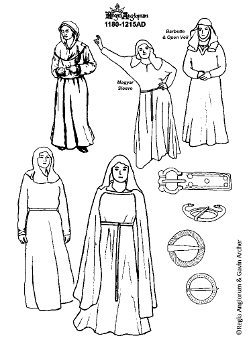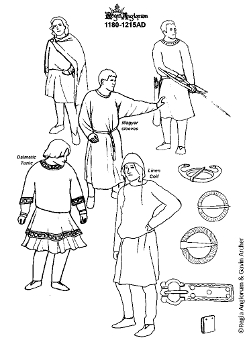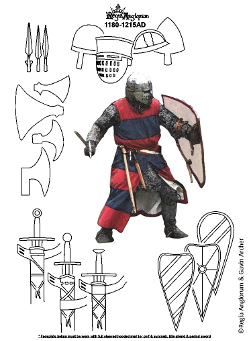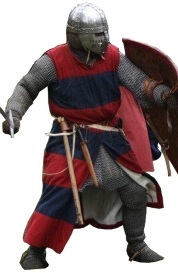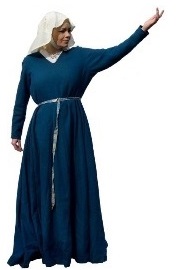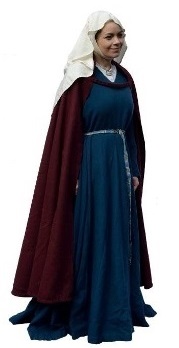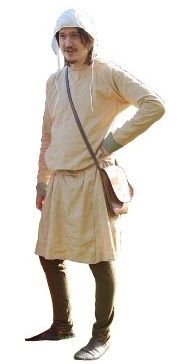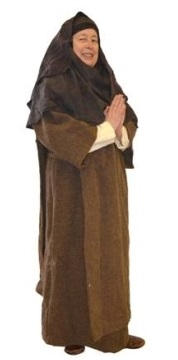Authenticity Officer’s Photo Guide – Examples of Authentic Kit
The Examples of Authentic Kit is a gallery of good examples of authentic kit, and can be used by members as a guide for what to aspire to. However, it is also an open competition amongst the membership, where they can submit photographs of themselves in kit – with examples of the most authentic kit being shown here.
All Periods
All Periods793 - 899
793 - 899900 - 979
900 - 979980 - 1041
980 - 10411042 - 1079
1042 - 10791080 - 1179
1080 - 11791180 - 1215
1180 - 1215The Angevins. King Richard and King John.
This period sees the introduction of the small open veil, an oval of white, cream or undyed cloth simply draped over the head, leaving the throat exposed. The hood like wimple is also sometimes still seen. The barbette, a fashion from southern France, is just starting to appear in the royal courts by the end of the period. Worn with an open wimple the barbette is a tight band worn under the chin and tied to the top of the head.
Dresses are very simple, ankle length with sleeves worn close to the wrist. Another popular style is the Magyar sleeve, which is loose at the upper arm with a wide join to the body of the dress creating a 'batwing' effect, and tight to the forearm. Rich women wear dresses with complicated tailoring, a tight bodice and a lot of fabric in the skirt. Most dresses are undecorated and dresses with loose or bliaut style sleeves would have appeared very old fashioned at this time.
Long tablet woven belts become fashionable, knotted or buckled at the waist and long enough to hang past the knees.
The ring style annular brooch is now almost worn exclusively having replaced the disc brooches of the previous centuries.
The primary garment is the tunic. Its skirt comes to the knee cap or just above and it’s always worn tight to the forearm and wrist. Neck-holes are either round or oval and often have a keyhole opening. Most tunics are undecorated.
Many men cover their hair with either a linen coif. Straw hats and hoods are also worn by working men.
Long belts become fashionable, knotted or buckled at the waist and long enough to hang past the knees.
Leg coverings, if worn at all, should be tight to the leg and are footed hose and braies. The leg bindings of the previous centuries are no longer worn.
Shoes or low boots are of the simple, two-part turn shoe construction. Most are low, coming to the ankle or below. Some wear boots that are slightly higher, coming up to the mid-calf and closed by either 3 laces or by toggles.
The ring style annular brooch is now almost worn exclusively having replaced the disc brooches of the previous centuries.
Weapons and armour are generally plain and utilitarian being mass produced. The third crusade at the end of the 12th century sees the introduction of the fully armoured knight.
In general warriors continued to use the same military equipment as they had in the years before, except that the kite shield is now used by all.
Knights on the other hand have access to the latest military equipment. Full mail shirts designed to cover the entire body including mailed mittens and foot covers. They wear full-faced helms and carry either a kite or heater shaped shield. Some are starting to wear simple plain surcoats over their armour.
There are a number of new types of weapons, including large axes and maces.
Mounted cavalry is the norm for knights and professional warriors. Archery is used in combat both by long bows and crossbows. Most arrows are bodkins, designed to pierce mail-shirts.
Chainmail with integral coif over padding, chausses, full face helmet, lined surcoat, shield and sword.
JonGown with tailored bodice, very full skirt with long hem. Magyar style sleeve shown, tight at the wrist and forearm, looser on the upper arm. Tablet woven belt with silver buckle and strap end. Annular brooch on underdress at neck. Open faced veil, with a barbette.
KatGown tight at the body with full skirt and Magyar sleeves and a tablet woven belt. Semi-circular cloak, tied open across the chest. Oval open faced wimple with barbette.
KatUndyed tunic with sleeves tight on the forearm, and small side gores, tight to the leg footed hose and turn shoes or low boots. Leather bag and coif.
Stuart